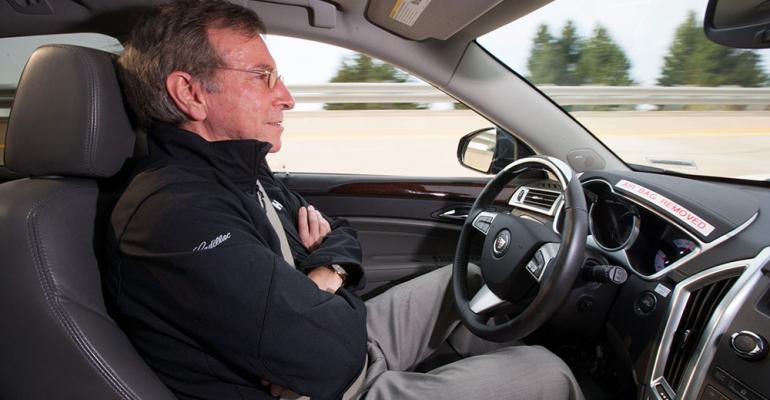ANN ARBOR, MI – Today’s vehicles are swallowing up new technologies so rapidly cars and trucks will drive themselves by the end of the decade, but experts warn the path to autonomy is not entirely unencumbered.
“I see very few roadblocks,” says John Capp, director-electrical and control systems research and active safety technology strategy at General Motors. “It’s more about the technology than anything and, like other features on the vehicle, (whether) customers (will) want them.”
Capp thinks drivers will find the technology gratifying, especially when their vehicle can take over in frustrating circumstances such as a traffic jam, and he sees little need for the sort of government incentives the nation’s electric-vehicle rollout has required for wider adoption.
“There’s more likely to be a market pull for the technologies,” he tells WardsAuto on the sidelines of a University of Michigan conference on the topic here. “And these technologies are much less expensive, so there will not be the same affordability issues.”
The U.S. Department of Transportation earlier this month announced a decision to move forward on connected vehicles and generate research on costs and safety advantages before mandating that future vehicles include the technology.
Concerns about whether technological advancements will permit connected and autonomous driving anytime soon are quickly diminishing, Capp says.
GM, for example, has been in the space for more than a decade, a research track that includes winning a U.S.-government-funded competition for self-driving vehicles in 2007. Many of the vehicles the automaker sells today use technologies from that Chevy Tahoe SUV, nicknamed “Boss” for GM R&D founder Charles “Boss” Kettering, such as full-speed adaptive cruise control and automated emergency braking.
A Cadillac SRX demonstrated last year by GM takes the Tahoe’s sensing and radar technologies a step further in the form of Super Cruise, which allows hands-free driving under the correct conditions. Capp says that technology will come to market this decade.
“We’re not waiting for a moonshot,” Capp says of GM’s development strategy.
Connected vehicles that communicate directly with each other, as well as through wireless devices and transportation-infrastructure elements such as stoplights, are seen as the first stepping stone to autonomous driving.
With autonomous driving, experts say, transportation safety will improve by reducing crashes. Commutes will move more smoothly, too, improving fuel economy and reducing carbon-dioxide emissions, while aging drivers will enjoy greater mobility.
Capp admits sensing technology must improve to create a vehicle that perceives its surroundings better, and global-positioning-system maps will need to be more accurate than the “five to 10 meters” (16-32 ft.) of precision they have today. All vehicles on the road will need to communicate with each other, as well, and it will take time to build an infrastructure capable of talking to them.
Standard vehicle-communications protocol must roll out, but Capp says work in that field has come a long way in just the past few years.
“From a concept standpoint, we’ve demonstrated that it can happen,” he says.
The closer the industry comes to connected and autonomous driving, the more potential risks have begun revealing themselves.
Andre Weimerskirch, an associate research scientist at the University of Michigan Transportation Research Institute, which currently is running the world’s broadest real-world test of connected-vehicle technology, says cybersecurity has emerged as a genuine threat.
Weimerskirch warns that researchers already successfully have hacked into a vehicle using the Bluetooth connection between a driver’s smartphone and the car. Once inside, the hackers can create havoc by turning off headlights or manipulating braking and steering. And unlike PC hackers, vehicle hackers need only a minute to cause trouble.
“The good thing is, it hasn’t happened in the real world,” Weimerskirch says. “The question now is when the first car will be hacked in the real world.”
An even greater risk would involve the potential hacking of the connected-vehicle infrastructure, where a densely trafficked region could be crippled by a jam-up. “It would take days to recover,” he says.
Weimerskirch suggests the industry should start considering cybersecurity in every element of the vehicle and incorporate safeguards early in the design process.
“Security is an enabler for success. Without it, this won’t work,” he says.
Industry players also must work together more closely than they have historically, says Amine Taleb, manager-advanced drive assistance programs at Valeo. No longer can suppliers simply deliver a part to the OEM, he says.
“We now have to talk to the person who does the brakes, the steering…we must work with everyone. It is a true cooperation,” Taleb says.





